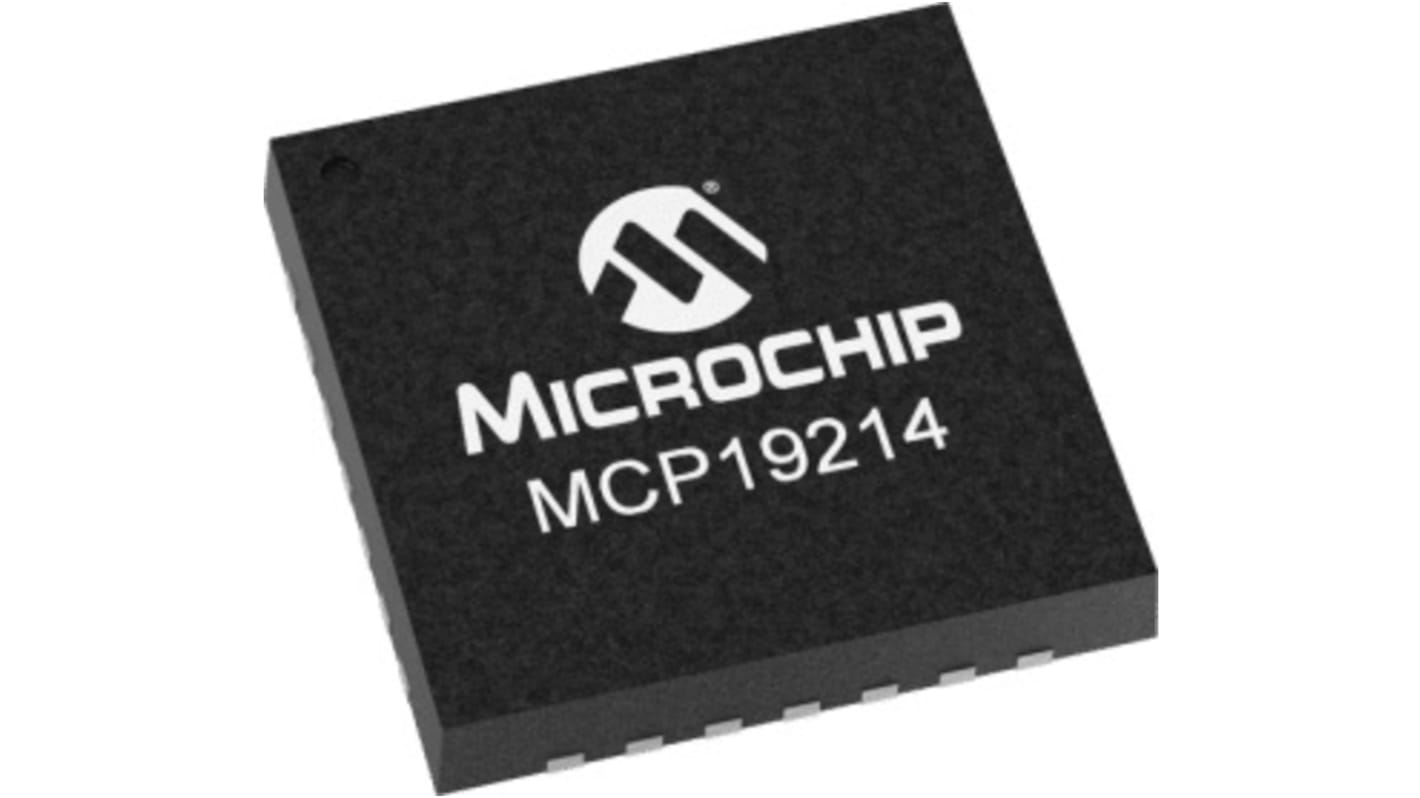Microchip MCP19214-E/MQ, Dual Buck Boost Switching, Buck Boost Controller 35A, 4.75 → 5.25 V, 2 MHz 28-Pin, QFN
- RS Stock No.:
- 175-3234P
- Mfr. Part No.:
- MCP19214-E/MQ
- Brand:
- Microchip

Subtotal 1 unit (supplied in a tube)*
£3.15
(exc. VAT)
£3.78
(inc. VAT)
FREE delivery for orders over £50.00
In Stock
- 15 unit(s) ready to ship
- Plus 999,999,984 unit(s) shipping from 13 October 2026
Need more? Click ‘Check delivery dates’ to find extra stock and lead times.
Units | Per unit |
|---|---|
| 1 + | £3.15 |
*price indicative
- RS Stock No.:
- 175-3234P
- Mfr. Part No.:
- MCP19214-E/MQ
- Brand:
- Microchip
Specifications
Technical Reference
Legislation and Compliance
Product Details
Find similar products by selecting one or more attributes.
Select all | Attribute | Value |
|---|---|---|
| Brand | Microchip | |
| Maximum Output Current | 35A | |
| Regulator Type | Buck Boost Switching | |
| Output Voltage | 4.75 → 5.25 V | |
| Number of Outputs | 2 | |
| Line Regulation | 0.1 %/V | |
| Load Regulation | ±1 % | |
| Mounting Type | Surface Mount | |
| Package Type | QFN | |
| Pin Count | 28 | |
| Output Type | Adjustable | |
| Maximum Switching Frequency | 2 MHz | |
| Switching Regulator | Yes | |
| Dimensions | 5 x 5 x 0.95mm | |
| Maximum Input Voltage | 42 V | |
| Height | 0.95mm | |
| Minimum Input Voltage | 4.5 V | |
| Maximum Operating Temperature | +125 °C | |
| Minimum Operating Temperature | -40 °C | |
| Width | 5mm | |
| Automotive Standard | AEC-Q100 | |
| Length | 5mm | |
Select all | ||
|---|---|---|
Brand Microchip | ||
Maximum Output Current 35A | ||
Regulator Type Buck Boost Switching | ||
Output Voltage 4.75 → 5.25 V | ||
Number of Outputs 2 | ||
Line Regulation 0.1 %/V | ||
Load Regulation ±1 % | ||
Mounting Type Surface Mount | ||
Package Type QFN | ||
Pin Count 28 | ||
Output Type Adjustable | ||
Maximum Switching Frequency 2 MHz | ||
Switching Regulator Yes | ||
Dimensions 5 x 5 x 0.95mm | ||
Maximum Input Voltage 42 V | ||
Height 0.95mm | ||
Minimum Input Voltage 4.5 V | ||
Maximum Operating Temperature +125 °C | ||
Minimum Operating Temperature -40 °C | ||
Width 5mm | ||
Automotive Standard AEC-Q100 | ||
Length 5mm | ||
- COO (Country of Origin):
- US
The MCP19214 is a dual-channel, mid-voltage (4.5-42V) analog-based PWM controller with an integrated 8-bit PICTM Microcontroller. This unique product family combines the performance of a high-speed analog control solution, including high-efficiency and fast transient response, with the configurability and communication interface of a digital solution.
Dual channel, for operating two power outputs from one controller
Constant-current or constant-voltage operation, with dynamic switching between those two control modes, and dynamic adjustment of the output level
Capable of bi-directional power supply control
Wide input operating voltage range: 4.5-42V
Analog peak-current mode Pulse-Width Modulation (PWM) control
Integrated 8-Bit PIC® Microcontroller
Complete configurability: adjustable output voltage, output current, MOSFET deadtime, leading edge blanking time, thermal responses, slope compensation, over-current
Constant-current or constant-voltage operation, with dynamic switching between those two control modes, and dynamic adjustment of the output level
Capable of bi-directional power supply control
Wide input operating voltage range: 4.5-42V
Analog peak-current mode Pulse-Width Modulation (PWM) control
Integrated 8-Bit PIC® Microcontroller
Complete configurability: adjustable output voltage, output current, MOSFET deadtime, leading edge blanking time, thermal responses, slope compensation, over-current
